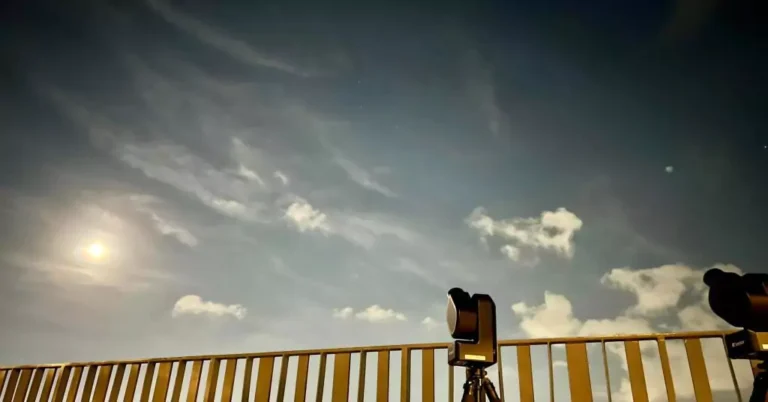Best Tripod for Telescope – 2026 Complete Buying Guide

Ever pointed your telescope at the moon, only to see everything shake and blur? That frustration ends here.
Even the most expensive telescope becomes useless without a solid foundation. Your tripod isn’t just a stand, it’s what turns a shaky, disappointing view into crystal-clear images of Saturn’s rings, Jupiter’s moons, and distant galaxies.
Whether you’re shopping for your first astrophotography tripod or upgrading your backyard setup, picking the right tripod for telescope can feel overwhelming. Should you go heavy-duty or lightweight? Aluminum or carbon fiber? What about those fancy slow-motion controls?
Don’t worry. We’ve tested dozens of best tripod brands like Celestron, Sky-Watcher, and JOILCAN to find options that actually deliver, for beginners and experts alike.
In this guide, you’ll discover:
- What makes a good tripod for binoculars and telescopes
- Top-rated models trusted by thousands of stargazers
- How to match your tripod to your viewing style
Table of Contents
How to Choose the Best Tripod for Telescope
Before we dive into reviews, let’s cover what really matters when shopping for a tripod for telescope or tripod for binoculars.
1. Stability Beats Everything Else
Your telescope magnifies every tiny shake. A wobbly tripod turns planets into blurry blobs.
What to look for:
- Thick aluminum legs or carbon fiber construction
- Wide leg spread for better balance
- Rubber feet that grip the ground
Think of it like this: Would you rather hold a camera perfectly still for 30 seconds, or rest it on a rock-solid table? That’s what a stable astrophotography tripod does for your telescope.
2. Height and Adjustability
Nobody wants to crouch down all night or stretch uncomfortably to see through their eyepiece.
The sweet spot:
- Extends to at least 60 inches for standing comfort
- Collapses to 30 inches or less for easy storage
- Adjustable legs for uneven ground
A good tripod for binoculars should let you observe comfortably whether you’re sitting on a chair or standing on a hill.
3. Head Type: Ball vs. Pan/Tilt
This determines how smoothly you can move your telescope across the sky.
Ball head = Quick, fluid motion in any direction (great for astrophotography)
Pan/Tilt head = Controlled, precise tracking (better for observing planets and the moon)
For most beginners, pan/tilt heads with slow-motion controls make it easier to follow celestial objects as Earth rotates.
4. Weight vs. Portability
Heavier tripods stay steadier in wind. But if you’re hiking to dark-sky sites, every pound matters.
Ask yourself:
- Will I mostly use this in my backyard? → Go heavier (more stable)
- Do I travel to different viewing spots? → Choose lightweight aluminum
The best tripod brands now make models that balance both, sturdy enough for clear views but light enough to carry.
5. Compatibility Check
Before you hit “buy,” make sure your tripod fits your gear.
Most tripods use:
- Standard ¼-inch screw threads (fits most cameras, binoculars, and small telescopes)
- 3/8-inch threads for heavier equipment
Pro tip: If you own multiple devices (telescope + binoculars + camera), look for universal compatibility. Many tripod for binoculars models work perfectly with telescopes too.
Top 7 Best Tripod for Telescope (2025 Reviews)
We tested these models across stability, ease of use, and real-world performance. Here’s what actually works.
1. Celestron Heavy Duty Tripod Review | best tripod telescope for beginners
The Celestron Heavy Duty Alt-Azimuth Tripod is the gold standard for backyard astronomy. From the moment you set it up, you’ll notice the professional-grade build quality, this isn’t a flimsy stand that wobbles at the slightest touch.
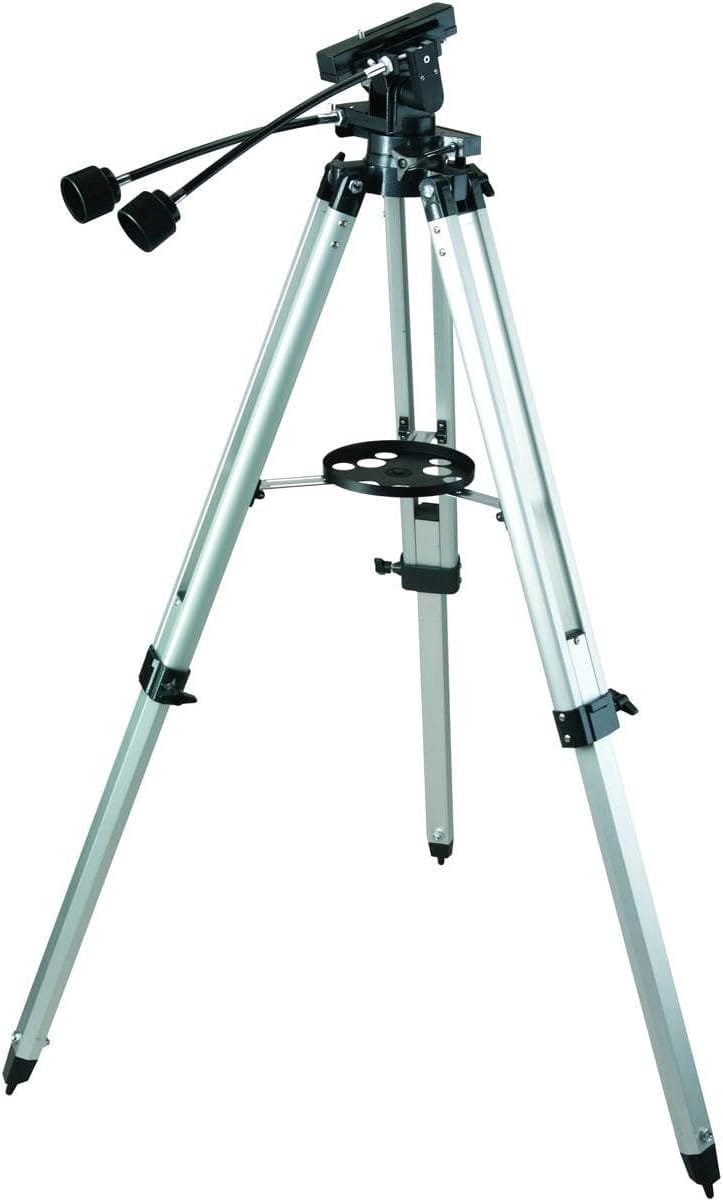
Celestron Heavy Duty Alt-Azimuth Tripod
The Celestron Heavy Duty Alt-Azimuth Tripod offers exceptional stability and smooth motion for telescopes and binoculars. Its adjustable height and sturdy build make it ideal for both beginners and advanced stargazers. Perfect for steady, vibration-free sky viewing.
What makes it special?
The dual slow-motion control handles let you track planets and stars with surgical precision. Instead of nudging your telescope and hoping it lands in the right spot, you smoothly glide left-right (azimuth) and up-down (altitude). It’s like having power steering for your telescope.
This astrophotography tripod isn’t just for telescopes. Attach your binoculars, spotting scope, or DSLR camera, and it performs just as beautifully. The aluminum frame absorbs vibrations, keeping your images sharp even on slightly uneven ground.
Specs:
- Material: Heavy-duty aluminum
- Leg Sections: 3
- Max Load: 10–12 lbs
- Weight: 7 lbs
- Max Height: 63 inches
- Folded Height: 36 inches
- Head Type: Pan/Tilt with slow-motion controls
Who should get this?
Perfect if you want the best tripod for telescope viewing from home. It’s strong enough for serious stargazing but easy enough for beginners to master in minutes.
Pros:
✓ Rock-solid construction
✓ Lightweight yet stable
✓ Easy assembly, no tools needed
✓ Smooth slow-motion controls
✓ Great for small to medium telescopes
Cons:
✗ Limited altitude range
✗ Center hinges could be sturdier
✗ Not ideal for large telescopes over 12 lbs
Best Features:
- Adjustable height from 36″ to 63″
- Metal accessory tray keeps eyepieces handy
- Dual slow-motion control handles
- Compatible with most telescopes and binoculars
2. Sky-Watcher Star Adventurer Tripod | Astrophotography
If you’re serious about astrophotography, the Sky-Watcher Star Adventurer Tripod deserves a spot in your gear bag. Built specifically for long-exposure night photography, it combines travel-friendly portability with the stability you need for capturing galaxies and nebulae.

Sky-Watcher Star Adventurer Tripod
The Sky-Watcher Star Adventurer Tripod provides a solid, stable base for astrophotography and stargazing. Designed for portability and precision, it ensures smooth tracking and steady shots of the night sky. Perfect for travel and field use.
This good tripod for binoculars and telescopes feels premium the moment you handle it. The stainless steel construction with reinforced aluminum joints creates a rock-solid base that doesn’t flex or wobble, even during 2-minute exposures.
What photographers love:
The wide, flat mounting plate gives you confidence that your expensive camera and telescope won’t tip. Leg locks are precise and tight, with no slippage after hours of use. Plus, it folds compact enough to fit in a backpack, making it perfect for chasing dark skies.
Specs:
- Material: Stainless steel with aluminum joints
- Leg Sections: 3
- Max Load: 15 lbs
- Weight: 8 lbs
- Max Height: 66 inches
- Folded Height: 35 inches
- Head Type: Pan/Tilt
Who should get this?
Ideal for astrophotographers who travel to different locations and need a reliable astrophotography tripod that’s both sturdy and portable.
Pros:
✓ Lightweight for its strength
✓ Quick setup in the field
✓ Works with multiple telescope systems
✓ Excellent value for money
✓ Height adjusts smoothly
Cons:
✗ Accessory tray sold separately
✗ Limited compatibility with very heavy scopes
✗ Not recommended for equipment over 15 lbs
Best Features:
- Travel-ready portability
- Professional-grade aluminum construction
- Compatible with Star Adventurer tracking mounts
- Standard mounting head fits most telescopes
- Adjustable legs for uneven terrain
3. Celestron Tabletop Dobsonian Tripod | Beginner Guide
The Celestron Tripod for Tabletop Dobsonians transforms compact telescopes into full-height observing stations. If you’ve ever hunched over a table to see through a tabletop scope, this tripod solves that problem instantly.
Designed specifically for Celestron’s StarSense Explorer Tabletop Dobsonian telescopes, this tripod for telescope beginners delivers surprising stability for its compact size. Setup takes less than two minutes, and the built-in accessory tray keeps your eyepieces and filters organized.
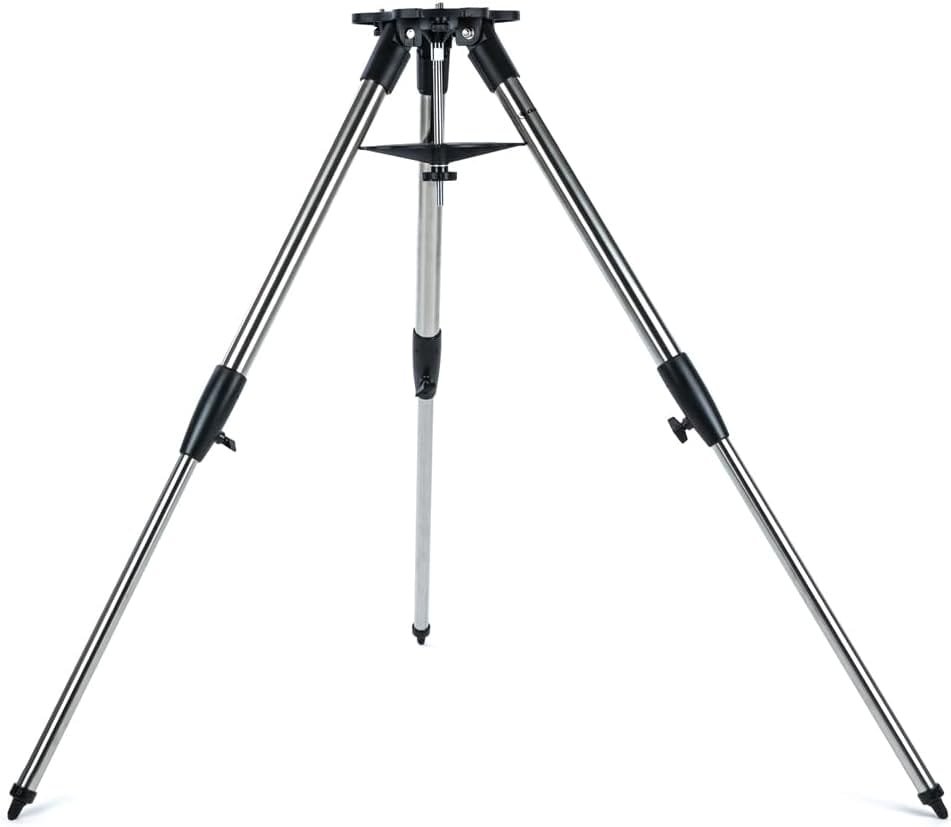
Celestron Tripod for Tabletop Dobsonians
The Celestron Tripod for Tabletop Dobsonians turns your compact Dobsonian telescope into a full-height setup. Lightweight yet sturdy, it offers stable support and easy portability for backyard or on-the-go stargazing.
What makes it beginner-friendly?
Everything is simple. Unfold the legs, attach your telescope, and you’re ready to explore. The aluminum construction stays steady even when kids are using it, and adjustable legs mean you can observe while sitting or standing.
Specs:
- Material: Aluminum alloy
- Leg Sections: 3
- Max Load: 8 lbs
- Weight: 5 lbs
- Max Height: 50 inches
- Folded Height: 28 inches
- Head Type: Pan/Tilt
Who should get this?
Perfect for families and beginners who want a good tripod for binoculars and small telescopes without spending hundreds of dollars.
Pros:
✓ Perfect fit for tabletop telescopes
✓ Well-designed and sturdy
✓ Super easy setup
✓ No more bending over tables
✓ Lightweight and portable
Cons:
✗ Higher price for its size
✗ Limited to smaller telescopes only
Best Features:
- Adjustable height up to 50 inches
- Built-in accessory tray
- Compact and portable design
- Secure telescope attachment system
- Stable on various surfaces
4. JOILCAN 81″ Heavy Tripod Review | Extra Tall Stand
The JOILCAN 81″ Heavy-Duty Tripod is a game-changer if you’re tired of crouching or adjusting your posture every few minutes. With its impressive 81-inch maximum height, this tripod for telescope and camera use lets you observe comfortably, whether you’re 5’5″ or 6’3″.
Built from premium aluminum alloy, it’s surprisingly portable for its size. The 4-section legs collapse down to just 30 inches, making it easy to transport in your car or store in a closet.
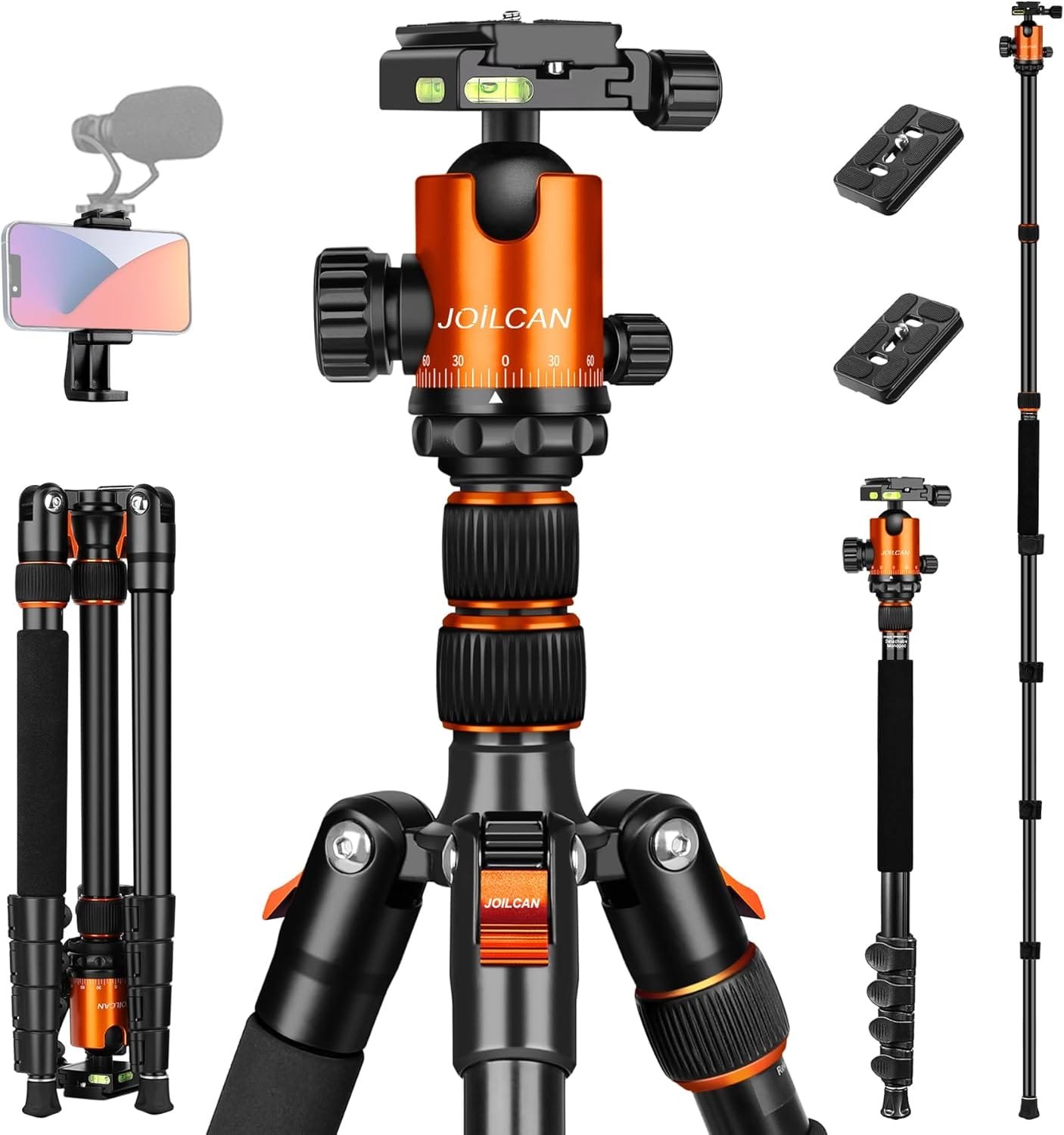
JOILCAN 81″ Heavy-Duty Tripod
The JOILCAN 81″ Heavy-Duty Tripod offers impressive height, stability, and versatility for cameras, spotting scopes, and phones. Built with durable aluminum, it’s perfect for professional photography, videography, and outdoor shooting.
What users rave about:
The 35-pound load capacity means you can mount larger telescopes, binoculars, or DSLR cameras with telephoto lenses without worry. Smooth pan and tilt adjustments make it easy to track celestial objects or follow birds in flight.
Bonus: Comes with a carry bag, phone holder, and quick-release plates, everything you need for instant setup.
Specs:
- Material: Heavy-duty aluminum alloy
- Leg Sections: 4
- Max Load: 35 lbs
- Weight: 14 lbs
- Max Height: 81 inches
- Folded Height: 30 inches
- Head Type: Pan/Tilt
Who should get this?
Best for observers who value height and versatility. This astrophotography tripod works equally well for telescopes, binoculars, and cameras.
Pros:
✓ Extra-tall viewing height
✓ Strong yet lightweight
✓ Smooth angle adjustments
✓ Durable construction
✓ Great price for the quality
Cons:
✗ Some users reported durability issues
✗ Heavier than ultra-portable models
Best Features:
- Adjustable up to 81 inches
- Lightweight design for its capacity
- Works with telescopes, binoculars, cameras
- 360° panoramic ball head
- Converts to monopod
5.MACTREM Travel Tripod Review | Lightweight & Portable
The MACTREM 67″ Travel Tripod is perfect for stargazers who refuse to choose between portability and performance. Weighing just 4.8 pounds, it’s one of the lightest best tripod brands options that still delivers solid stability.
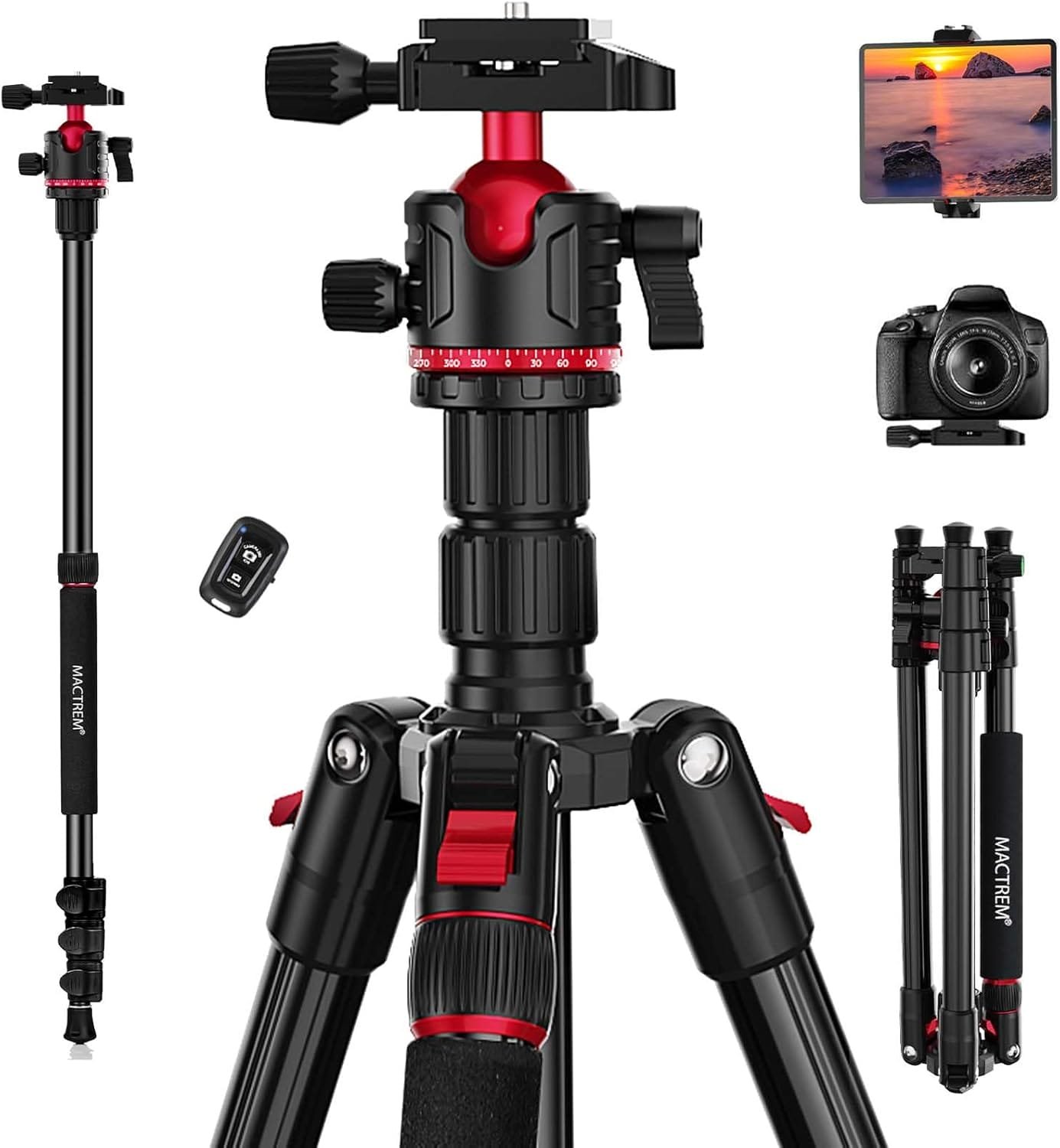
MACTREM 67″ Aluminum Travel Tripod & Monopod
The MACTREM 67″ Aluminum Travel Tripod & Monopod combines portability and strength for photographers on the go. Easily converts from tripod to monopod, offering stability, flexibility, and smooth shooting anywhere you travel.
The secret? 2-in-1 versatility.
One of the legs detaches to create a monopod, ideal for quick wildlife shots or handheld stability when hiking to remote viewing spots. The 360° ball head ensures smooth panning, making it excellent for both astrophotography and landscape photography.
At 67 inches fully extended, it provides comfortable viewing height without the bulk of heavier models. Strong leg locks keep it stable even on rocky terrain or grass.
Specs:
- Material: Aluminum alloy
- Leg Sections: 3
- Max Load: 15 lbs
- Weight: 4.8 lbs
- Max Height: 67 inches
- Folded Height: 24 inches
- Head Type: 360° Ball head
Who should get this?
Ideal for travelers and hikers who need a tripod for binoculars and telescopes that won’t weigh them down on the trail.
Pros:
✓ Ultra-lightweight and portable
✓ Easy to assemble
✓ Sturdy despite low weight
✓ Converts to monopod
✓ Excellent customer service
Cons:
✗ Not suitable for very heavy equipment
✗ Initial setup may feel complex
Best Features:
- Lightweight 4.8 lbs
- 360° swivel ball head
- Adjustable height from 24″ to 67″
- Macro photography mode
- Includes carry bag
6. CAMBOFOTO Fluid Head Tripod | Smooth Telescope Tracking
The CAMBOFOTO 68″ Fluid-Head Tripod is the multitasker of telescope stands. Whether you’re filming time-lapses of the Milky Way, watching birds at dawn, or tracking planets through your telescope, this good tripod for binoculars and cameras delivers silky-smooth motion.
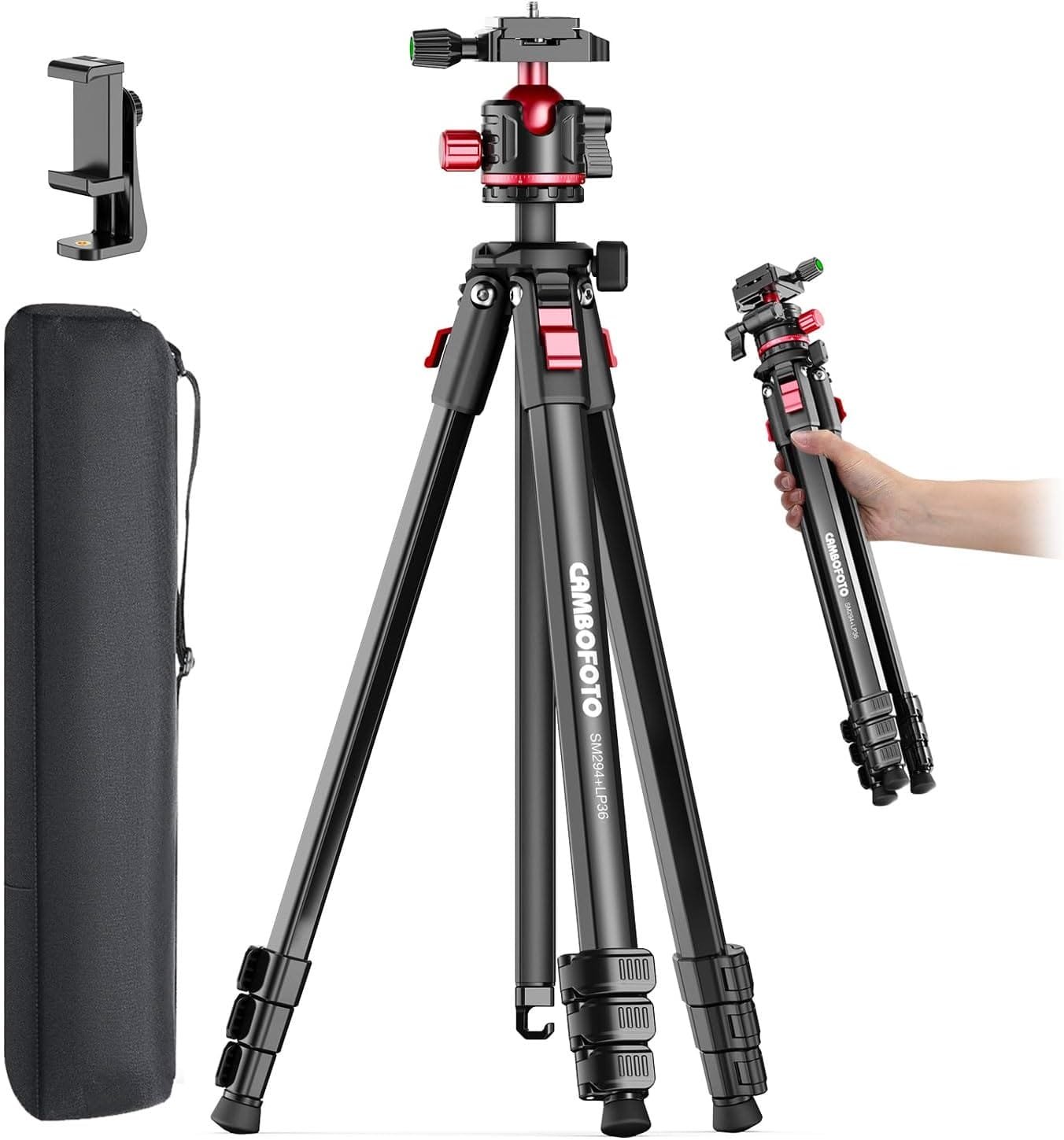
CAMBOFOTO 68″ Fluid-Head Tripod
The CAMBOFOTO 68″ Fluid-Head Tripod delivers smooth pan and tilt motion, ideal for video recording and photography. Its sturdy aluminum build and adjustable height ensure stable, professional-quality shots in any setting
What makes it different?
The fluid head design eliminates jerky movements. When you pan across the sky or tilt to follow a moving object, it glides effortlessly, no sudden stops or vibrations. That smoothness is crucial for video recording and precise telescope tracking.
Despite its professional features, it remains affordable and lightweight at just 7.5 pounds. The aluminum construction provides surprising stability for equipment under 8.8 pounds.
Specs:
- Material: Aluminum alloy
- Leg Sections: 3
- Max Load: 8.8 lbs
- Weight: 7.5 lbs
- Max Height: 68 inches
- Folded Height: 22 inches
- Head Type: Fluid Pan/Tilt
Who should get this?
Perfect for users who switch between cameras, spotting scopes, and small telescopes. This tripod for telescope viewing excels at versatility.
Pros:
✓ Sturdy and stable
✓ Lightweight design
✓ Ultra-smooth fluid head
✓ Quick setup
Cons:
✗ Limited height adjustment
✗ Some plastic components
✗ Not for heavy cameras or large telescopes
Best Features:
- Compact folded size
- 360° pan rotation
- 8.8 lb load capacity
- Dual bubble levels for perfect alignment
- Quick-release plate system
7. 72″ Heavy Duty V-Yoke Tripod | Large Telescope Stand
The 72.4″ Heavy-Duty Tripod is built for serious observers who use spotting scopes, large binoculars, or heavier telescopes. With a massive 22-pound load capacity, this astrophotography tripod provides the rock-solid foundation needed for high-magnification viewing and long-exposure photography.
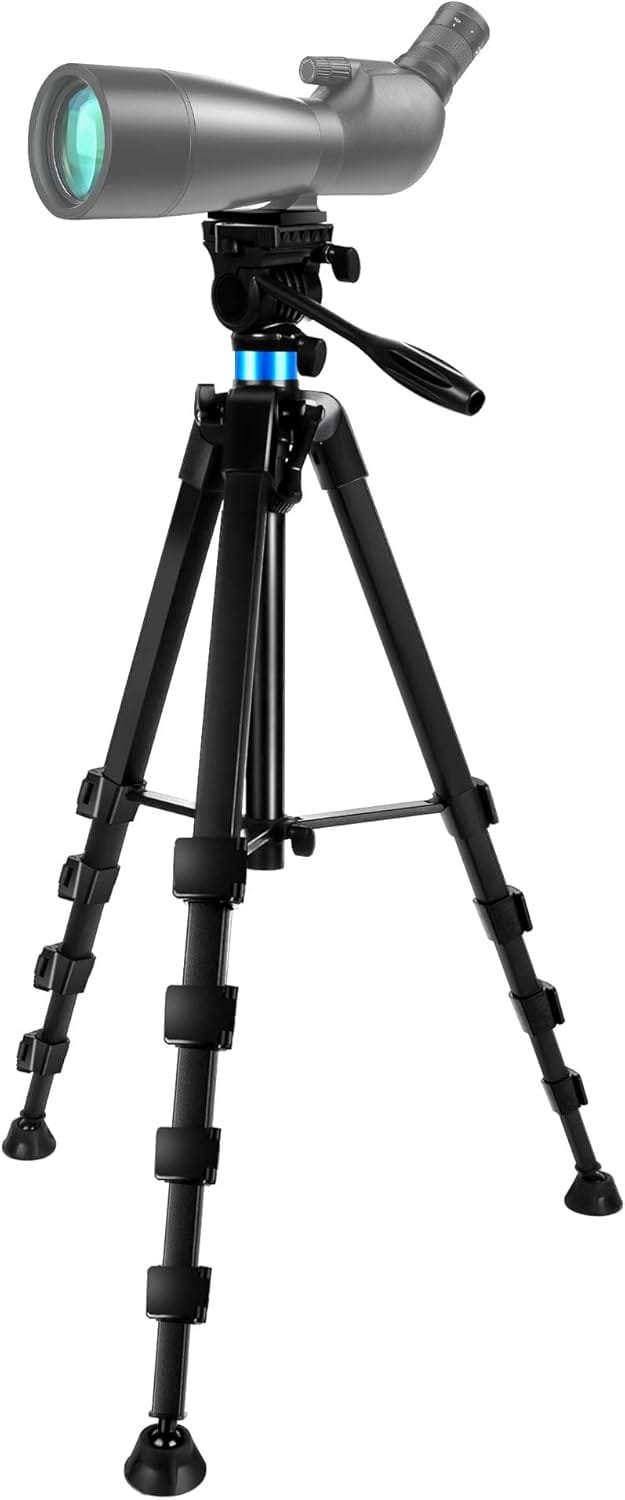
72.4″ Heavy-Duty Tripod with V-Yoke (Max 22 lbs)
The 72.4″ Heavy-Duty Tripod with V-Yoke supports up to 22 lbs, making it perfect for spotting scopes, binoculars, and rifles. Built for strength and stability, it offers adjustable height and precise aiming for outdoor and hunting use.
What sets it apart?
The V-Yoke stand design distributes weight perfectly, keeping your equipment balanced even on uneven ground. At 72.4 inches tall, it’s especially comfortable for taller users who’ve struggled with shorter tripods.
Users consistently praise how it eliminates vibration, even at 200x magnification. Whether you’re observing distant wildlife or photographing nebulae, this tripod keeps your view crystal clear.
Specs:
- Material: Steel/Aluminum hybrid
- Leg Sections: 4
- Max Load: 22 lbs
- Weight: 19.8 lbs
- Max Height: 72.4 inches
- Folded Height: 33 inches
- Head Type: Pan/Tilt with V-Yoke adapter
Who should get this?
Best for dedicated astronomers and wildlife watchers who need maximum stability and aren’t concerned about portability.
Pros:
✓ Incredibly sturdy
✓ Surprisingly lightweight for capacity
✓ Excellent value
✓ Includes useful accessories
✓ Perfect for backyard observatories
Cons:
✗ Plastic crank could be sturdier
✗ Not truly heavy-duty for extreme conditions
Best Features:
- Durable aluminum construction
- Works with most telescopes and binoculars
- Quick-release plate
- Lightweight relative to capacity
- Compact folded design
Comparison Table: Best Tripod for Telescope
| Model | Max Height | Max Load | Weight | Best For | Price Range |
| Celestron Alt-Azimuth | 63″ | 12 lbs | 7 lbs | Home use | $$ |
| Sky-Watcher Star Adventurer | 66″ | 15 lbs | 8 lbs | Astrophotography | $$$ |
| Celestron Tabletop | 50″ | 8 lbs | 5 lbs | Beginners | $$ |
| JOILCAN 81″ | 81″ | 35 lbs | 14 lbs | Versatility | $$ |
| MACTREM 67″ | 67″ | 15 lbs | 4.8 lbs | Travel | $ |
| CAMBOFOTO 68″ | 68″ | 8.8 lbs | 7.5 lbs | Video/Photo | $$ |
| 72.4″ Heavy-Duty | 72.4″ | 22 lbs | 19.8 lbs | Large scopes | $$$ |
Conclusion:
Choosing the best tripod for telescope comes down to understanding your needs. Are you observing from your backyard? Traveling to dark-sky sites? Photographing deep-sky objects? Each scenario demands different features.
Quick Recommendations:
- Best overall: Celestron Heavy Duty Alt-Azimuth (stability + ease of use)
- Best for astrophotography: Sky-Watcher Star Adventurer (travel-ready + professional)
- Best for beginners: Celestron Tabletop Dobsonian (simple + affordable)
- Best height: JOILCAN 81″ (comfort + versatility)
- Best travel: MACTREM 67″ (lightweight + durable)



